Meet the OPP’s local canine officer, Sarah Hendrick, and her hard-working wonder dogs, Janus and Finny.
by Dianne Rinehart // Photography by Anya Shor & Roger Klein
When OPP Constable Sarah Hendrick starts her day, she puts on a military-style uniform and boots, and then loads up with 20 pounds of gear, including a ballistic vest, a firearm, ammunition, a controlled-energy weapon, pepper spray, a baton, handcuffs—oh, and a ball, a Kong and a leash—before leaving to pick up her two partners.
By the time she’s at her garage door, she can hear Janus, a four-year-old Belgian malinois, and Finny, a two-year-old Labrador retriever, waiting, and whining, on the other side, doggedly eager to go to work.
Unlike other partners, the dogs don’t need a coffee. They just jump into their kennels, in the back of her super-equipped Chevrolet Suburban, rarin’—or is that roaring?—to go. And that could be anywhere—to a scene where Janus might be called upon to apprehend an armed suspect, or the backwoods, where Finny could be asked to find a missing child.
Meanwhile, Hendrick also needs to be ready to run with them wherever they go—to apprehend someone who is a danger to the public or hang off the edge of a helicopter to lower her dog down to terrain that is too difficult to land on.
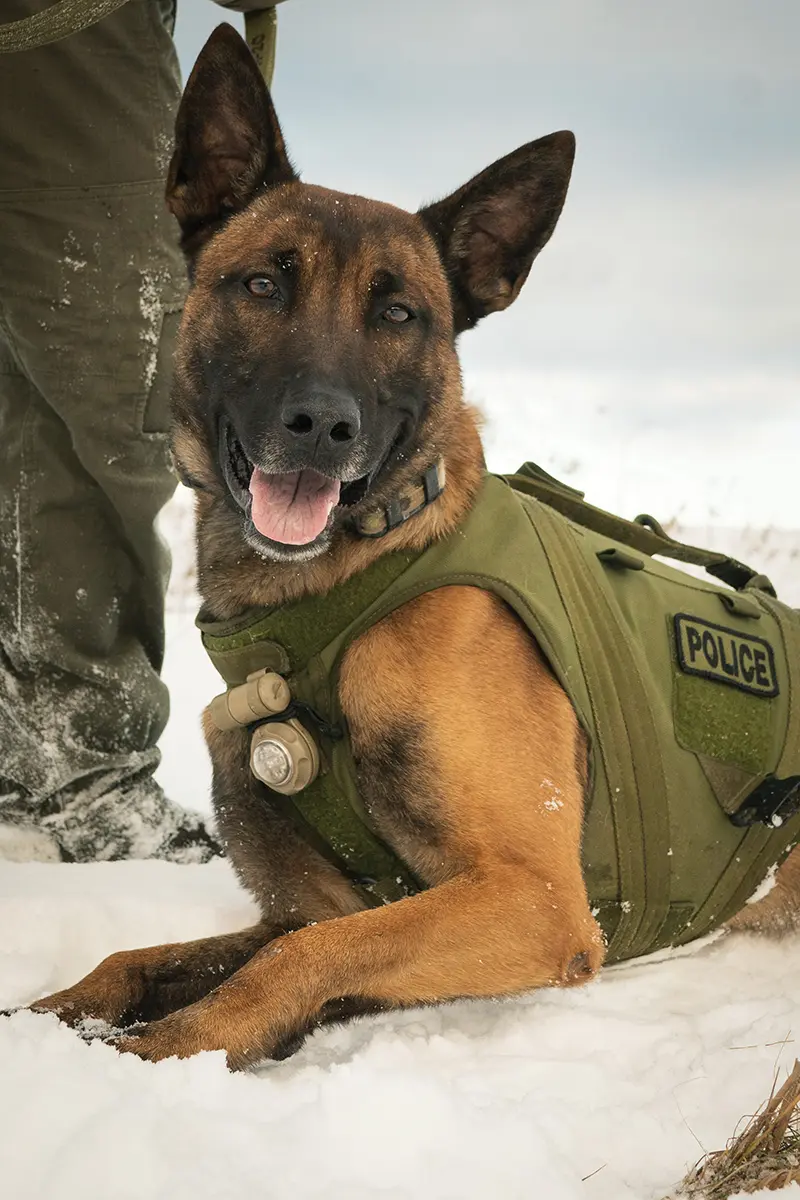
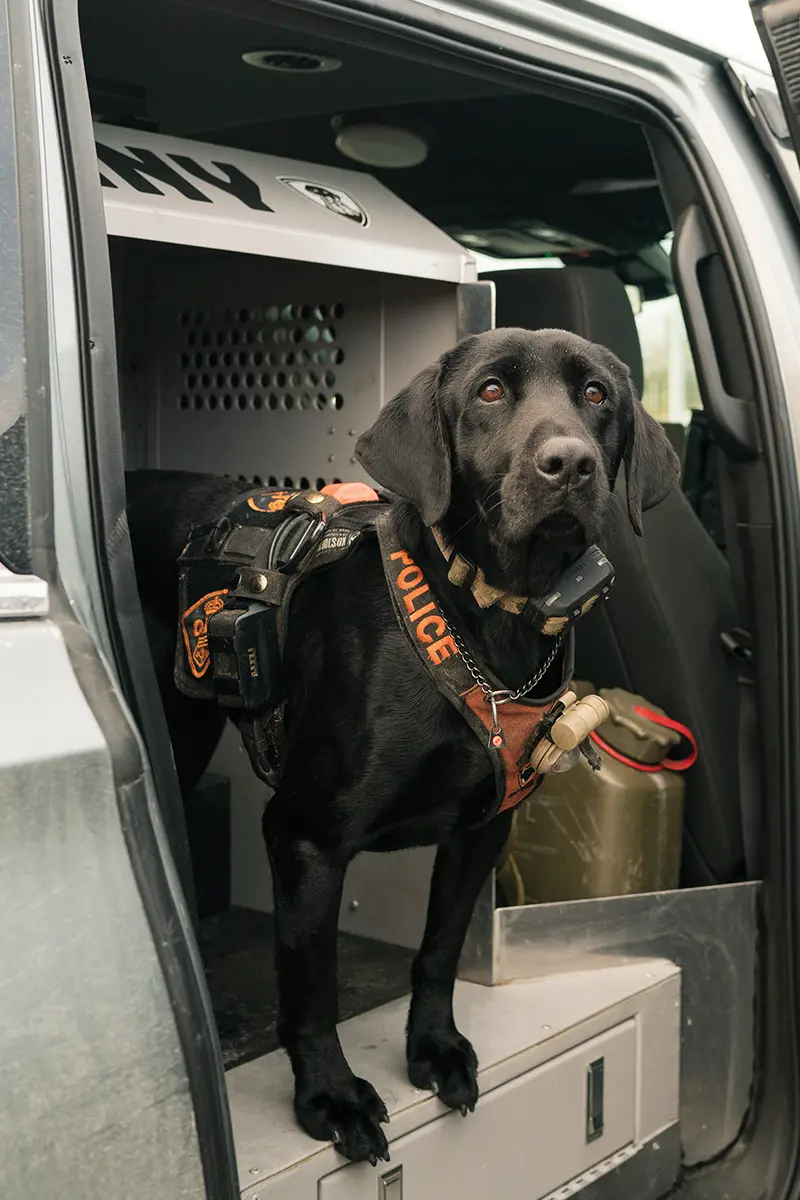
By the time she returns from assignments for the canine unit (she and her dogs are on call 24-7), Hendrick will finally get to assess the damages. Once, “Janus cut his paw on something,” she says. “It was pretty deep, and he had to get stitches. I didn’t know until the end of the day. He kept tracking and was completely fine with it.”
Sometimes dogs in the canine unit break their tails. Or ingest drugs they are sniffing for. Or get stabbed. But their safety and health are of a prime concern to their handlers. Hendrick notes, wryly, that she has a first-aid kit in her truck for her dogs, but not one for herself.
The OPP also has its own veterinarian, who knows and treats all the dogs. And specially-trained medics go on the high-risk jobs to treat the dogs in the field. Hendrick says she doesn’t know of an OPP dog that has ever been killed on the job, but last year a Toronto Police dog, Bingo, was shot by a suspect he was tracking.
In the high stress of an apprehension or a tracking situation, she trusts that “Janus can handle the situation that can be faced. Then, afterward, that’s when you become a regular dog owner. That’s when you make sure they haven’t been stabbed or ingested drugs.”
And it isn’t all chocolates and roses for Hendrick either. She must keep up her tetanus shots, because she may get cut climbing over metal or barbed-wire fences as she follows one of her dogs. And, of course, there are the twigs, ticks, bugs, leaves and other foliage that fall out of her gear and out of her khaki green uniform (the better to hide the dirt and debris)—which is either soaked with sweat or as stiff with cold as she is.
Yup, where they go on four legs, she goes on two.
Indeed, Hendrick travels with enough food and gear for herself and her dogs to last for 36 hours. Because she covers so much territory, the OPP issues her with two sets of special heavy-duty boots a year and a boot dryer—“because canine officers’ boots are always wet.”
But Hendrick, who had 18 years of other policing work under her belt before becoming one of five female canine officers in the OPP’s team of 30, loves her job as much as her dogs love theirs.
Is it scary? “Yes,” says Hendrick. “But it’s just a job to be done. They try to put us through enough circumstances that happen operationally, that we believe our dogs will be successful and we’ll
be successful.”
No matter what time of the day or night she gets a call, she and her partners are ready to go.
“They love working,” says Hendrick. “They’re not happy to sit at home and do nothing. In the morning, they will eagerly stick their necks out and lift their paws to get their harnesses on.”
And there is a bond that can’t be broken between canine officers and their dogs. Hendrick says she doesn’t know of any canine officer who didn’t adopt their partners as pets when the dogs were retired.
“I spend more time with them than I’ve ever spent with any partner at work,” she says.
That is an understatement. The dogs live with her and her family in insulated kennels in her backyard—they can’t be inside where they would get used to being cozy-warm in winter or comfortably cool in the summer, since they must be able to work in tough weather conditions on the job. And she even takes them on family vacations, when she can, rather than putting them into a kennel.
Weirdly, it’s Janus, the tough-looking Belgian malinois, who is the most affectionate. “From the first day I got him, he leaned in to get pets,” says Hendrick. And, also, unexpectedly, it turns out that Finny is the boss, even though Janus is twice her size. But the two love each other.
The American Kennel Club describes the Belgian malinois breed as “a world-class worker who forges an unbreakable bond with his human partner.” These dogs look like German shepherds, but they are much more athletic. Indeed, Janus competed in the Canadian Police Canine Association Trials in Barrie last year and clocked 47 kilometres per hour—in an arena with slippery floors—to win. “He’s pretty fast,” says Hendrick understatedly.
Janus, who is from Holland, was 14 months old when he was assigned to Hendrick. First, the two of them went through an 18-week training course that teaches the dog to track, apprehend people and search for articles with a human scent. A couple of months later, Janus and Hendrick returned for a five-week course for drug and gun detection. After that, they train one week out of every six.
“It’s amazing what they are good with,” Hendrick says. “They are used to being in boats, helicopters and planes. They can work around loud noises.”
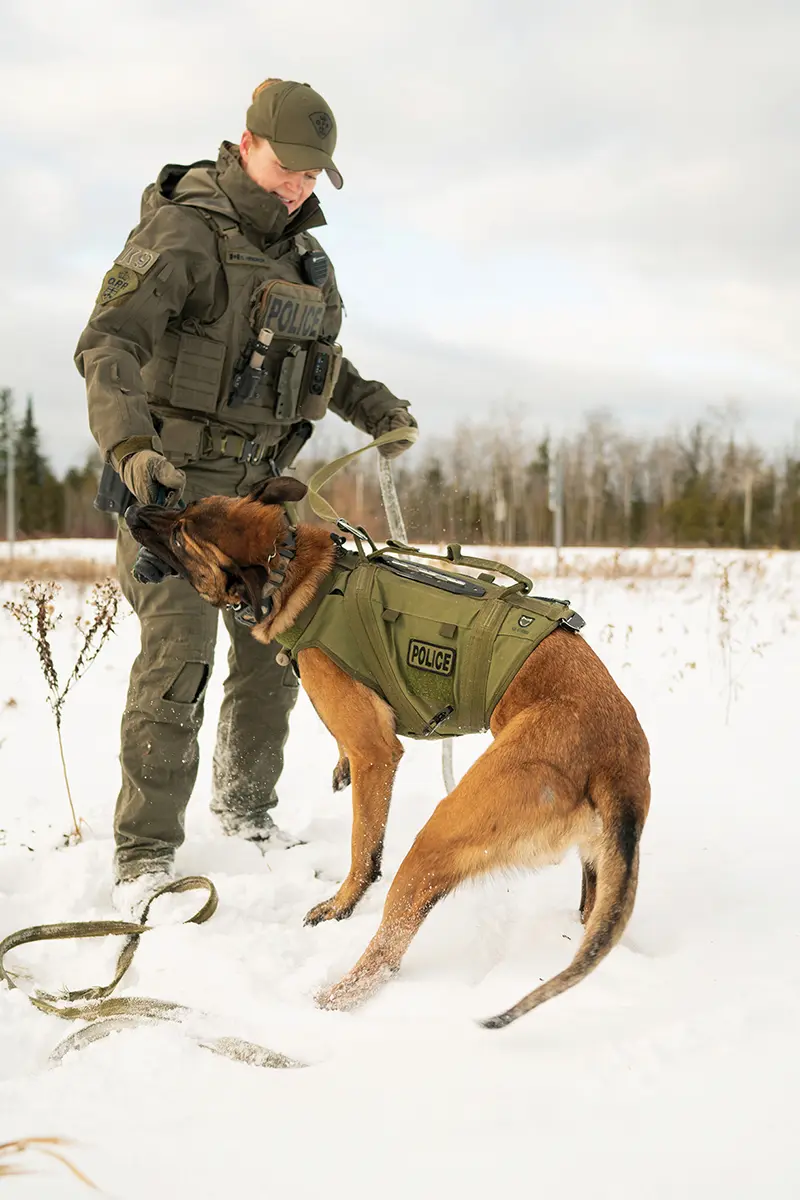
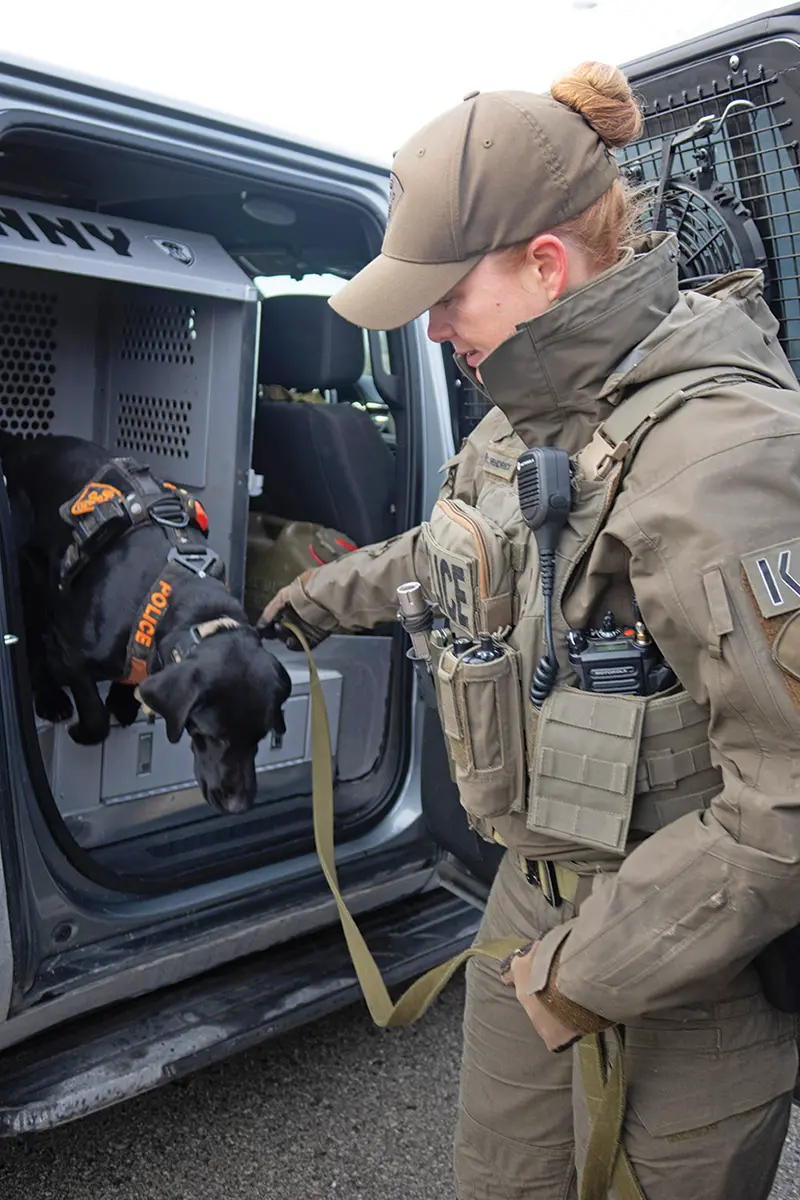
Part of the training for Janus is learning how to bite. That may sound surprising, but Hendrick says “biting a human is not a natural thing that a dog wants to do. It takes a lot of training to develop that.” It starts when they are puppies and are playing with jute “biting toys.” Next, the dogs learn how to bite padded sleeves, and then, padded men’s suits that the trainers wear.
They are trained only to apprehend for arms and legs. “There’s the least amount of injury potential in these locations,” says Hendrick.
While Janus will do anything for a pet from Hendrick, you could joke that Finny will do anything for her ball. “Her ball drive is insane,” says Hendrick, of her Lab who only seeks out “pets” at the end of the day when all the work is done.
Hendrick was assigned Finny, a black Lab from Washington state, when the dog was 16 months old. She had a 12-week course for search and rescue, then a two-week course to search for human remains.
And there is special training on helicopters. The rotor wash alone can be a lot, but then the dogs must learn to get on and off the helicopter—or be dropped down from the helicopter by their handler in their harnesses.
“It’s amazing what they are good with,” Hendrick says. “They are used to being in boats, helicopters and planes. They can work around loud noises.”
And while a lot of the training is complicated, some of it is basic—and hilarious. For example, when Finny finds a missing person, she will bark constantly at them—demanding her ball. Yes, that’s right, her ball. That’s because in training, everyone who is hiding has a ball. When Finny finds them, she gets rewarded with it.
Meanwhile, Janus has been rewarded so many times for finding whatever substance he is tasked to sniff out, that he will do it anytime, anywhere.
No matter how long a trained police dog has been retired for, if you put them in a room with one of those substances they will indicate it, Hendrick says.
When they’re not on an assignment, the dogs are happy to hang out in the kennels in the truck. The temperature is regulated, and if it gets too hot or too cold, the engine automatically starts to provide air conditioning or heat. “If that fails, then all the windows will go down and a siren and lights will be activated to alert people,” says Hendrick.
Hendrick, too, must be in shape to do her job, which requires her to follow Finny for long distances at a super-fast walking pace over uneven ground when she is tracking. In addition to running, she does weight training to prepare herself to lower Finny down to the ground from a helicopter or lift her or Janus up and over fences when they are tracking someone.
Dogs can cover two-and-a-half times the area a person can cover, says Hendrick, so “we try to use them as much as possible.”
When she and her dogs get called out to track people, they come together with other officers at a command post. Then they pull up topographic maps and try to determine where it is best to search for a person. Every case has different characteristics that can help the canine officers locate the right area to search. They look at the terrain and ask, where would a hunter go? Or where would someone with dementia go?
Then they go to work.
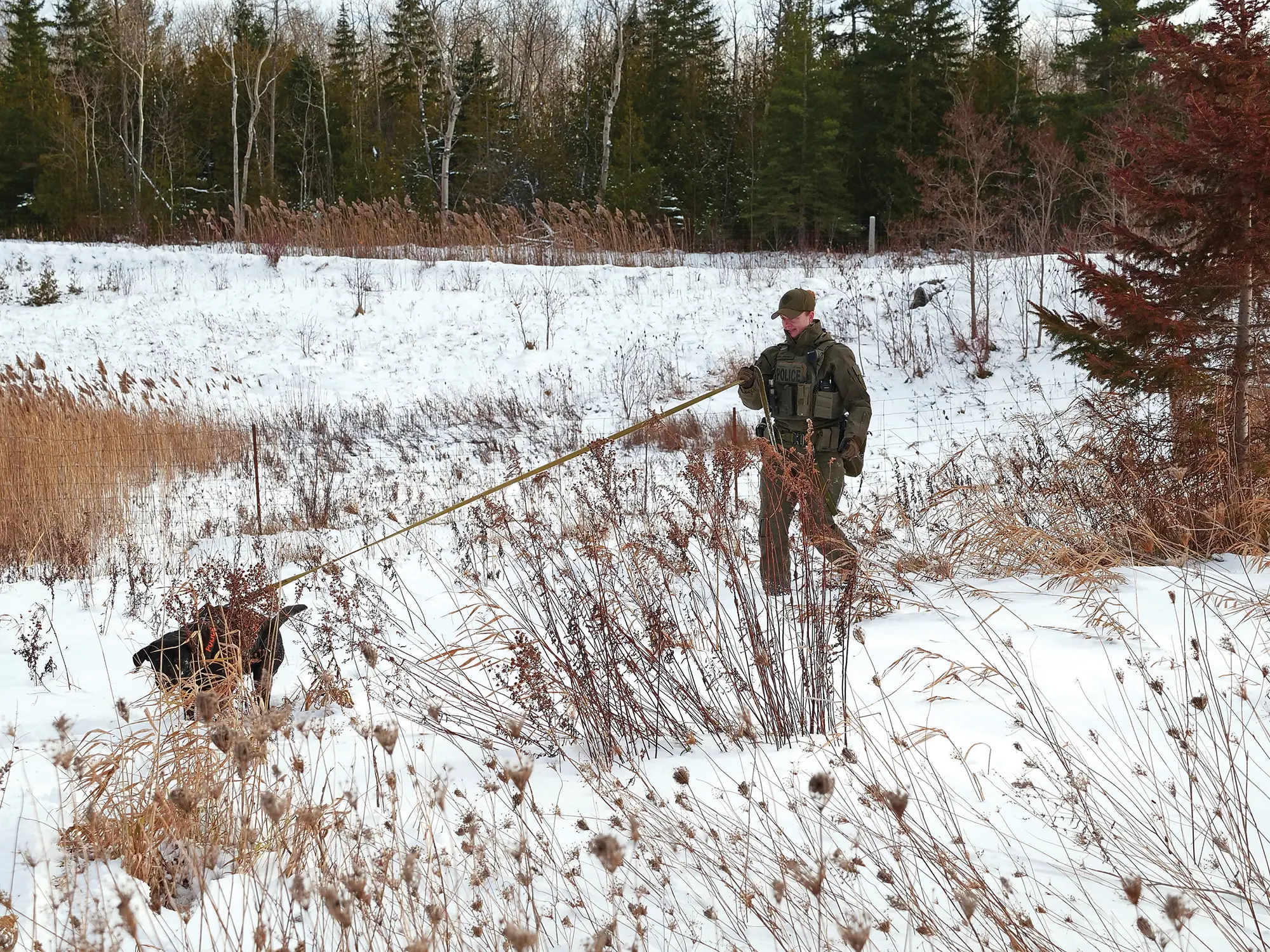
The dogs wear GPS units, as do the officers. When a dog stops moving, and they are a distance away, an alarm sounds. That’s because “our dogs don’t stop,” unless there’s a reason, says Hendrick. “So, you go to that location.”
When they are in the field, the dogs are suited up almost as much as their handlers. The dogs wear expensive, individually fitted ballistic vests that support them, so that if Hendrick has to lift them up and over a fence, or “haul” them from a helicopter, they feel secure.
On the day she is interviewed, Hendrick is bright and professional. That belies the fact that she and her dogs were called out three nights in a row for emergencies this week. At this point she is just a bit over halfway through the year, and already she estimates she’s been on 125 calls—which are in addition to her regular shifts (unless they happen while she is on shift).
You could say Hendrick was born to do the job she is in, not because anyone in her family was in policing, but just because it is such a fit for her personality.
She first started with the OPP as a summer student with the OPP’s marine unit. Right away she loved the work, so she enrolled in the criminal justice program at the University of Guelph. By the time she was 21, just months before she completed her degree, she was hired.
In her first general policing job in Windsor, she met a canine handler and was intrigued by the work. But it was 18 years before she would be accepted into the unit, during which time she worked in anti-rackets, as a detective in the corruption unit, with the organized crime enforcement bureau—where she often worked joint operations with the RCMP—and investigating homicides.
But her heart lay with the canine unit, so she began volunteering with the officers there by laying tracks to help train the dogs and hiding for them. Four years of doing that, in addition to her regular challenging police duties, and she was finally accepted into the canine unit.
It’s hard work, but the end results are so rewarding.
A year ago, a dog was found wandering along the highway in the Southern Georgian Bay area with a leash attached to his collar. Police were called. When they canvassed homes in the area, they were told that an elderly gentleman owned the dog. But when the police went to his home, he wasn’t there. So, they searched the house and the yard and a forested area behind the house.
Then Hendrick and Finny were called in, along with about 20 more officers. She and Finny started searching in long grass up to her chest, which Finny had to hop upwards and through so she could see ahead, Hendrick remembers. They searched for an hour, and then Hendrick decided to head back to the command post to grid the area with the other officers who were arriving. But then she noticed a change in Finny’s behaviour.
You could say Hendrick was born to do the job she is in, not because anyone in her family was in policing, but just because it is such a fit for her personality.

That’s all it takes when you know your dog, she explains. No one else might have noticed it, but she did. “She ran to the east, then came to a woven wire fence, and she was trying to ram herself through it, and then running up and down along the fence looking to get through.
“I lifted her over the fence, and she took off. She got 70 metres, and I heard her starting to bark. She was standing in front of the gentleman. He was very dehydrated and said he had been there for two days.
“I was super proud of Finny, for sure. She did everything she was supposed to do.”
A few months earlier, in Wasaga Beach, it was Janus who saved the day. An assault occurred and a male fled through multiple backyards. “I was called to track and search for him,” says Hendrick. By the time she got there, uniformed officers had located him. But witnesses said he had a firearm, and it wasn’t on him. “We needed to search for that.”
Hendrick headed into a shed with officers to start the search, but Janus pulled her behind it.
“As I came around, he was frozen, he was showing me his response to locating a detection article.” But he was indicating a bag of peat moss. “Sure enough, when I opened the bag, it was in there.”
It wasn’t Janus’s first time at that rodeo. He has found three or four guns that people have hidden when they were about to be captured, she says.
Of course, there have also been times when Hendrick has had to send Janus into dangerous situations to apprehend suspects who she knew were armed.
“I do care for Janus immensely,” she says. “But we have to remember when we take this job, it’s human lives over the dogs’ lives. It’s public safety. That’s our utmost duty as a police officer. If I put him in danger, it’s to help save a member of the public or an officer.”












